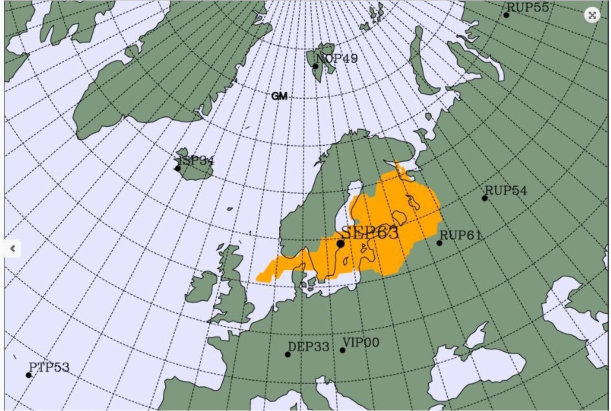
Radioactivity levels have spiked in the atmosphere over northern Europe, and that could indicate damage at a nuclear power plant in western Russia, according to a Dutch health agency that has analyzed the data. The radioactive spike suggests damage to a nuclear fuel element, the Associated Press reported. However, the Russian nuclear power operator Rosenergoatom has denied problems related to facilities in Kola and Leningrad, the two nuclear plants operating in the region, according to TASS, a Russian news agency, as reported by the AP.
22 /23 June 2020, RN #IMS station SEP63 #Sweden detected 3isotopes; Cs-134, Cs-137 & Ru-103 associated w/Nuclear fission @ higher[ ] than usual levels (but not harmful for human health). The possible source region in the 72h preceding detection is shown in orange on the map. pic.twitter.com/ZeGsJa21TNJune 26, 2020
detected 3isotopes; Cs-134, Cs-137 & Ru-103 associated w/Nuclear fission @ higher[ ] than usual levels (but not harmful for human health). The possible source region in the 72h preceding detection is shown in orange on the map. pic.twitter.com/ZeGsJa21TNJune 26, 2020
Several Scandinavian watchdog agencies detected the elevated levels of the radionuclides (or radioactive isotopes). Radionuclides are atoms whose nuclei are unstable; the excess energy inside the nucleus gets released through radioactive decay. In particular, concentrations of the radionuclides cesium-134, cesium-137 and ruthenium-103 rose in parts of Finland, southern Scandinavia and the Arctic, Lassina Zerbo, the Executive Secretary of the Comprehensive Nuclear-Test-Ban Treaty Organization, wrote on Twitter. Though these pose no harm to humans, they are byproducts of nuclear fission, Zerbo wrote.

Several Scandinavian watchdog agencies detected the elevated levels of the radionuclides (or radioactive isotopes). Radionuclides are atoms whose nuclei are unstable; the excess energy inside the nucleus gets released through radioactive decay. In particular, concentrations of the radionuclides cesium-134, cesium-137 and ruthenium-103 rose in parts of Finland, southern Scandinavia and the Arctic, Lassina Zerbo, the Executive Secretary of the Comprehensive Nuclear-Test-Ban Treaty Organization, wrote on Twitter. Though these pose no harm to humans, they are byproducts of nuclear fission, Zerbo wrote.
“The radionuclides are artificial, that is to say they are man-made. The composition of the nuclides may indicate damage to a fuel element in a nuclear power plant,” an official with the National Institute for Public Health and the Environment in the Netherlands, which analyzed the isotope data, said on Friday (June 26). Because so few measurements have been taken, monitoring agencies weren’t able to identify a specific source, NIPHE officials said. The sudden radioactivity spike echoes the events following the Chernobyl nuclear meltdown, the biggest nuclear disaster in history. Within a few days of the 1986 disaster, a Swedish nuclear power plant detected elevated radioactivity levels, according to an account from the European parliament.
In recent years, another radioactive mystery cloud wafting over Europe was tied to Russia. In 2017, a plume holding 1,000 times the normal levels of ruthenium-106 was detected over Europe, The Washington Post reported. Russia denied any involvement, though a nuclear reprocessing plant in Russia was a strong suspect, according to a 2019 study in the journal Proceedings of the National Academy of Sciences. –Live Science

Comments
Post a Comment